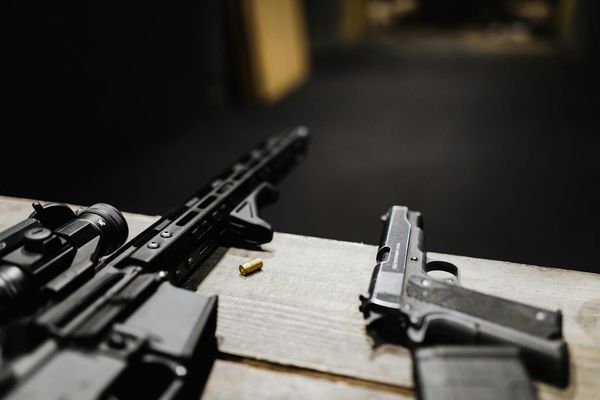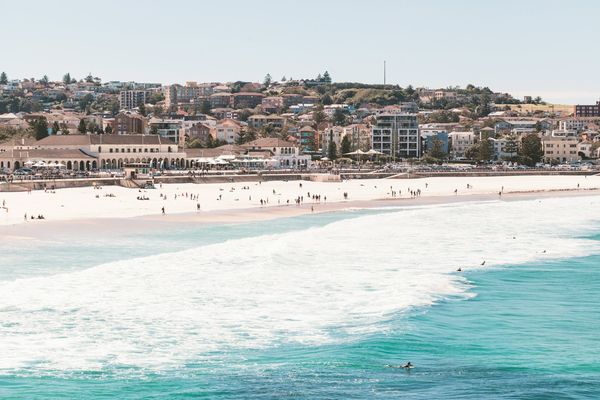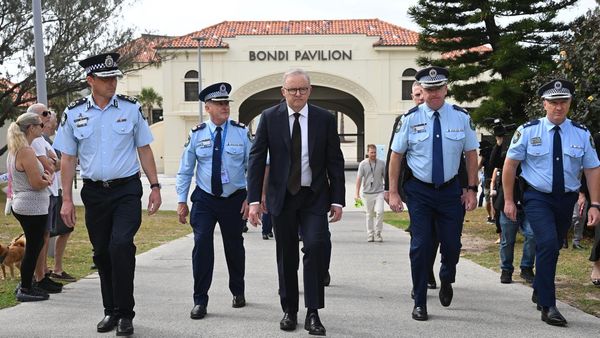
At the Northwest Ice Processing Center in Tacoma, Washington, about 1,500 people in immigration detention await their day in court. Most are held for months, living not by the rising and setting sun but under the perpetual twilight of fluorescent lights.
“We couldn’t tell if it was day or night,” said one former detainee who spent 10 months at the facility and whom the Guardian is not naming for fear of retaliation from US Immigrations and Customs Enforcement (Ice) and the Geo Group, the private company that operates the detention center. “The lights were on 24/7. We maybe saw the sun twice a week.” Windows were coated in dark paint, and people made eye masks with their socks, he recalled.
Similar stories echo from other Ice facilities. Immigrants detained in “Alligator Alcatraz”, the harsh immigration detention center in the Florida Everglades; at 26 Federal Plaza, the main detention facility in New York City; and at the Los Angeles federal courthouse on Spring Street, a holding center known as B-18, have declared in class-action lawsuits against officials with Ice and the Department of Homeland Security (DHS) that their cells lacked windows or were flooded with constant artificial light. So have immigrants who have been held in Guantánamo Bay, the notorious US naval base in Cuba tapped earlier this year to hold Ice detainees. “We lost track of time,” one of the immigrants who was held in Guantánamo said in court filings. “It felt like hell.”
The tens of thousands of immigrants held across the US as Donald Trump scales up his immigration crackdown face an insidious hazard: broken internal clocks.
Conditions vary among Ice facilities, but accounts from detainees and advocates suggest commonalities: in many centers, detainees have limited access to daylight and are exposed to excessive light throughout the night. This is problematic for the human body, whose biological timekeeping system relies on bright blue-rich light during the day and darkness at night. A dampened day-night distinction disrupts circadian rhythms and the critical aspects of physiology they regulate: digestion, immunity, sleep and more.
“Light at night is bad, but it’s even worse if you don’t get a bright exposure during the day,” said Horacio de la Iglesia, a circadian biologist at the University of Washington, in Seattle. “Our circadian and sleep regulatory systems evolved to respond to extreme contrasts between dark nights and bright days.”
Christopher Ferreira, a spokesperson for the Geo Group, said that “the Northwest ICE Processing Center provides high quality support services that adhere to ICE’s detention standards and contract requirements, which provide for ample access to pre-scheduled recreation opportunities both indoors and outdoors. Individuals at the Center are in no way deprived of natural light nor are they subjected to excessive artificial light.
“GEO strongly rejects these baseless claims, which are preposterous and bizarre,” Ferreira said.
Access to healthy light and dark has an opaque history that has only become more transparent over time. When England imposed a tax on windows in the 17th through 19th centuries, many homeowners, especially landlords, simply bricked them up. An 1845 editorial in the Lancet cautioned: “Light is as necessary to the perfect growth and nutrition of the human frame as are air and food; and, whenever it is deficient, health fails, and disease appears.” A century later, George Orwell portrayed round-the-clock illumination as torture in his book 1984. A federal court in Oregon reached the same conclusion in 1990, deeming constant light unconstitutional. And in 2018, while children were held under constant light in a Texas warehouse during the previous Trump administration, the New England Journal of Medicine warned of the “profound” consequences.
“Not much has changed, sadly,” said Steve Lockley, a circadian neuroscientist and visiting sleep researcher at the University of Surrey, in England.
But circadian science and technology have significantly advanced. Studies now show that disruptions to inner clocks and sleep can raise the risk of heart disease, diabetes, infertility, depression, dementia, cancer and premature death. The concerns have risen high on the radar of another federal agency: more than a decade ago, Lockley began advising Nasa on circadian lighting for the International Space Station to help astronauts adapt to the 16 daily sunrises and sunsets they experience in orbit.
In the Tacoma Ice facility, a healthy contrast of bright days and dark nights remains hard to come by. Inside, light levels vary minimally across 24 hours, according to former and current detainees, as well as lawyers representing immigrants at various Ice facilities. Zahid Chaudhry, a current detainee in the Tacoma facility, reports no windows and rare yard time. “Last week, we got an hour [of yard time] and it was raining,” he said. One of two bright overhead lights in his pod is turned off around midnight and turned back on at 4.30am, he said. When he spent a week in a more restrictive unit, a constant, unchanging bright light shone overhead, he said. “I had no idea if it was morning or night,” he said. “There wasn’t even a clock.”
An Ice spokesperson, Chrissy Cuttita, said that the agency “follows strict standards”, and pointed to Ice’s official detention standards, a 226-page document updated in 2025. It contains no mention of how light should be regulated at night. The one reference of “access to natural light” does not define what qualifies as access. Cuttita also said that “contrary to any preposterous notion ICE keeps detained illegal aliens in the dark recesses of detention facilities, ICE’s high living standards provide ample pre-scheduled recreation time outdoors”.
In reality, the detainees at Tacoma said they got at most an hour in the sun a day – still often enough to meet the minimum outdoor recreation requirement. However, that’s only if their allotted yard time falls during daylight hours and doesn’t conflict with a legal meeting or mealtime, said Elizabeth Benki, directing attorney at the Northwest Immigrant Rights Project. The Ice spokesperson acknowledged the possible conflict: “If an attorney shows up during an alien’s allotted recreation time then the alien has to make that choice to forfeit fresh air for legal counsel.” Construction recently trimmed that time further, according to the lawyer.
Many of Ice’s detention centers are not run by the agency itself, but by private companies like the Geo Group.
No one set of standards applies to all government-run or privately run detention centers. “Even Ice standards are inconsistent across facilities,” said Eunice Cho, senior counsel at the American Civil Liberties Union’s National Prison Project. “It’s a mishmash, and it’s constantly evolving.”
The latest Ice standards, revised in 2025, state that facilities “shall ensure appropriate temperatures, air and water quality, ventilation, lighting, noise levels, and detainee living space, in accordance with any applicable state and local jail/prison standards”. Where such state or local standards exist, the focus is generally on light for surveillance or adequate visibility for reading, writing or grooming. Some local authorities do get explicit about daylight access, such as in New York City, where guidance for new facilities calls for the total area of windows in each living quarter to be “at least one-tenth the floor area of such room”. Still, aside from isolated court orders for individual facilities, there are currently no federal standards that mandate how much light or how much darkness an incarcerated person or immigrant detainee must have.
Recognizing this gap, the Illuminating Engineering Society, an internationally recognized authority on lighting, is currently drafting standards for spaces of confinement it hopes authorities will adopt. The document will account for significant differences in how the visual and circadian systems process light, said Patricia McGillicuddy, senior manager of technical content for the non-profit society. A room that looks bright to the eye, for example, can still be biologically dim. “The standards won’t be code,” she said. “But they can be adopted by an authority with jurisdiction.”
The American Bar Association, too, has proposed standards for civil immigration detention. Their document states that residents should be able to “turn off lights that might impede sleep”. It also calls for “abundant natural light”. Yet the standards have no binding legal authority, said Cho of the ACLU.
Most people in the US and Europe live with some circadian disruption, largely due to the modern indoor lifestyle. As the days rapidly shorten at this time of the year, many people commute to work or school in the dark and return home in the dark. Their worlds are illuminated almost solely by artificial light. Still, the burden falls unevenly.
People in poverty disproportionately live in basement apartments or social housing built to comply with the minimum standards of lighting. They more often work in warehouses, kitchens or cubicles far from any windows. Their children are more likely to study in windowless classrooms and to lack safe spaces to play outside. Then, after a dimly lit day, the whole family may be drenched in the glow of streetlights and headlights. Some public housing complexes in London and New York City are lit like construction sites, or prison yards.
Studies confirm that low-income residents and people of color are exposed to more light at night than their wealthier, white peers. The consequences include not just health risks, but also behavioral issues as well as lower wages and test scores – all of which help perpetuate the cycles of inequity, and incarceration.
Natural light deprivation has been a longstanding concern in US detention facilities. Nearly 2 million people in the US wake up every morning in jails or prisons. Lockley served as an expert witness on a class-action lawsuit filed by Vermont prisoners concerning the constant illumination of their prison cells. After years of litigation, the parties reached a settlement: correctional facilities would keep cell lights dim and sleep masks would be made available to incarcerated people.
Cho said the standards for immigration detention centers should be even higher than that of prisons. “These are civil detainees. They can’t be subjected to any punishment, let alone cruel and unusual punishment,” she said.
The solutions can be simple, and cheap, both in places of detention and incarceration. Daylight is free. And safety doesn’t require blinding light at night, scientists say. Dim, warm bulbs can provide visibility while protecting health and cutting costs. Providing free eye masks could protect individuals from any remaining light that is necessary.
“We need to put issues of light and darkness up alongside issues of nutrition and access to clean air and clean water,” said Lya Osborn, a Seattle-based lighting designer and founding member of the non-profit Light Justice. “Those impacted the most are those least able to identify it as a problem and ask for change.”
The best public interest journalism relies on first-hand accounts from people in the know.
If you have something to share on this subject, you can contact us confidentially using the following methods.
Secure Messaging in the Guardian app
The Guardian app has a tool to send tips about stories. Messages are end to end encrypted and concealed within the routine activity that every Guardian mobile app performs. This prevents an observer from knowing that you are communicating with us at all, let alone what is being said.
If you don't already have the Guardian app, download it (iOS/Android) and go to the menu. Select ‘Secure Messaging’.
SecureDrop, instant messengers, email, telephone and post
If you can safely use the Tor network without being observed or monitored, you can send messages and documents to the Guardian via our SecureDrop platform.
Finally, our guide at theguardian.com/tips lists several ways to contact us securely, and discusses the pros and cons of each.







